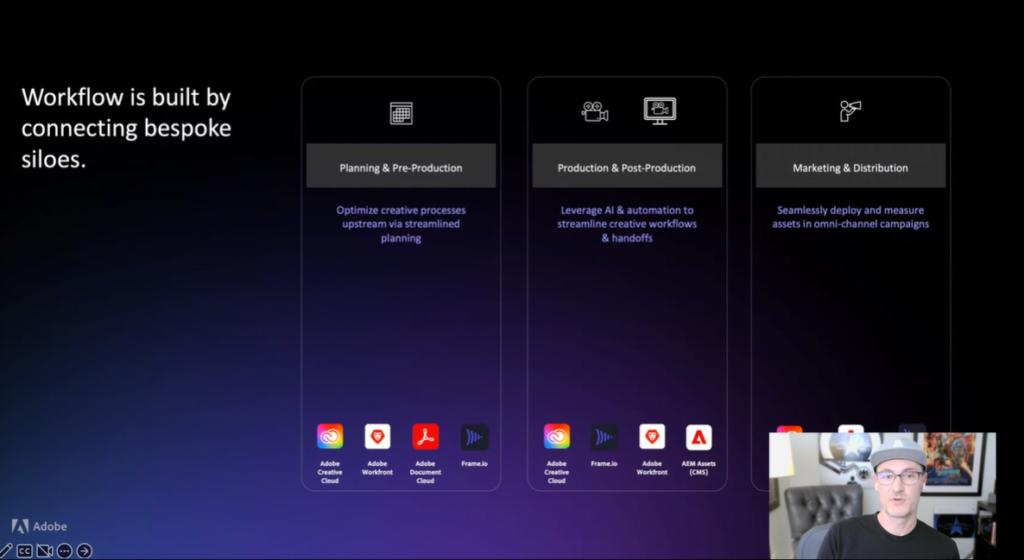M+E Connections

Adobe: How Frame.io Helps Build an End-to-End Production Workflow
Story Highlights
The extensibility of Adobe’s Frame.io cloud-based collaboration platform can plug into Workfront, the company’s project management platform, to help drive an organization’s team productivity and speed time to market by leaning on automation, according to the company.
“There’s no two workflows that are alike,” Matt Crnich, Frame.io solutions manager at Adobe, said Sept. 20, during the “Building an end-to-end production workflow” webinar, part of the “Adobe Pro Video: Meet the Makers” series.
During the session, he said, the combination of Frame.io and Workfront can “supercharge your workflows beyond human scale and maybe also keep your artists happy at the same time.”
Workfront, he explained “is a project management platform that keeps teams and enterprises running efficiently, even in the face of unpredictable challenges,” and It’s a “source of truth for feedback and status throughout the entire content supply chain.” It is a top layer that he said “sits above and orchestrates all the platforms.”
 The underlying application programming interface (API) of Frame.io, he said, is the “foundation which unlocks superpowered automations and connectivity into existing business platforms.” And Frame.io is a “highly secure” Software-as-a-Service (SAAS) platform, which he said means “you don’t need to install any software.”
The underlying application programming interface (API) of Frame.io, he said, is the “foundation which unlocks superpowered automations and connectivity into existing business platforms.” And Frame.io is a “highly secure” Software-as-a-Service (SAAS) platform, which he said means “you don’t need to install any software.”
And “we’re all working together, breaking down … silos to work at that API layer,” said Crnich, adding: “That’s really where the fun starts here.”
The Supply Chain Ecosystem
“I think one of the things that we’re definitely seeing as it relates to the digital media supply chain, just broadly, [is] I think there’s this education that’s happening or more awareness that the content supply chain isn’t simply a single solution: It’s an ecosystem, according to Mike Whang, VP of digital media supply chains at global consulting firm Qvest.US.
“And I think more of our clients are beginning to see that this is a holistic approach of which there’s some key components,” he said.
“Whether you’re talking about master data or mass management or work project workflows or content automation or the creation of content … in this conversation, we’re talking about the creation of video content throughout the life cycle,” he noted.
“What’s encouraging to see,” he added, is that a growing number of people in the sector now “understand that it takes multiple things to put it all together to get the full end-to-end delivery working, all the way through to the distribution and the measurement and analytics.”
The Importance of Scale
“We’re all dealing with scale” today and “we’re all going to hear the same thing every budget cycle: ‘We need to find a way to do more with less,’” according to Clayton Dutton, Frame.io solutions architect at Adobe.
Agreeing with Dutton, Whang said: “The scale is what’s really kind of changing” now.
He pointed to the “exponential” growth we are seeing in the amount of short form content being created. There is, as a result, he said a “burden that’s being placed on … teams to create this content.”
Adobe acquired cloud video collaboration platform Frame.io in 2021. At the time, Shantanu Narayen, Adobe CEO, chairman and president, said it would help Adobe reach new customers.
“The addition of Frame.io creates an opportunity for Adobe, in conjunction with the partner ecosystem, to expand beyond video editors to a broader set of customers, teams and enterprises,” Narayen said Sept. 21 during an earnings call for Adobe’s third quarter and fiscal year (ended Sept. 3).
To view the entire webinar, click here.









